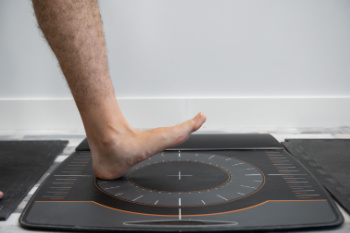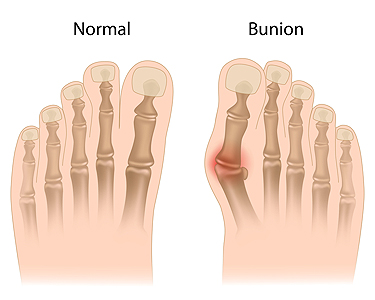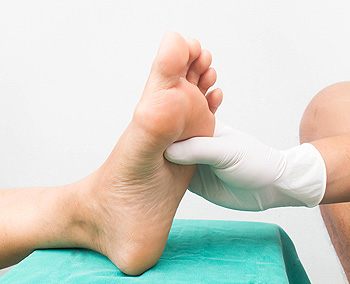Connect With Us
Blog
Items filtered by date: August 2024
The Intricate Structure of the Foot

The foot’s structure is a marvel of anatomical design, consisting of 26 bones, numerous ligaments, and several joints that work harmoniously to support movement and balance. The major bones include the calcaneus, talus, and metatarsals, which form the framework of the foot. Ligaments, such as the plantar fascia and the deltoid ligament, provide stability and help maintain the arch. The ankle joint, where the tibia and fibula meet the talus, allows for flexibility and movement, which is essential for walking and running. Together, these components facilitate a range of movements while absorbing impact and distributing weight evenly. If you have injured your foot, it is suggested that you consult a podiatrist who can treat any foot condition, and can answer any questions you may have about the foot’s structure.
If you have any concerns about your feet, contact one of our podiatrists from Boca Raton Podiatry . Our doctors can provide the care you need to keep you pain-free and on your feet.
Biomechanics in Podiatry
Podiatric biomechanics is a particular sector of specialty podiatry with licensed practitioners who are trained to diagnose and treat conditions affecting the foot, ankle and lower leg. Biomechanics deals with the forces that act against the body, causing an interference with the biological structures. It focuses on the movement of the ankle, the foot and the forces that interact with them.
A History of Biomechanics
- Biomechanics dates back to the BC era in Egypt where evidence of professional foot care has been recorded.
- In 1974, biomechanics gained a higher profile from the studies of Merton Root, who claimed that by changing or controlling the forces between the ankle and the foot, corrections or conditions could be implemented to gain strength and coordination in the area.
Modern technological improvements are based on past theories and therapeutic processes that provide a better understanding of podiatric concepts for biomechanics. Computers can provide accurate information about the forces and patterns of the feet and lower legs.
Understanding biomechanics of the feet can help improve and eliminate pain, stopping further stress to the foot.
If you have any questions please feel free to contact our office located in Boca Raton, FL . We offer the newest diagnostic and treatment technologies for all your foot and ankle needs.
Reminder: When Was the Last Time...?
Causes and Symptoms of Bunions

Bunion pain arises from a bony bump at the base of the big toe, often caused by genetic factors, improper footwear, or foot deformities. Wearing tight, high-heeled, or narrow shoes worsens the condition, pushing the toe out of alignment and increasing pain. Symptoms include swelling, redness, and difficulty moving the affected toe. To find relief, start by switching to well-fitting, comfortable shoes with ample room for the toes. Using orthotic devices or bunion pads can help cushion and realign the foot. Gentle foot exercises may improve flexibility. If you see signs of a bunion developing, it is suggested that you consult a podiatrist for effective treatment methods.
If you are suffering from bunions, contact one of our podiatrists of Boca Raton Podiatry . Our doctors can provide the care you need to keep you pain-free and on your feet.
What Is a Bunion?
A bunion is formed of swollen tissue or an enlargement of boney growth, usually located at the base joint of the toe that connects to the foot. The swelling occurs due to the bones in the big toe shifting inward, which impacts the other toes of the foot. This causes the area around the base of the big toe to become inflamed and painful.
Why Do Bunions Form?
Genetics – Susceptibility to bunions are often hereditary
Stress on the feet – Poorly fitted and uncomfortable footwear that places stress on feet, such as heels, can worsen existing bunions
How Are Bunions Diagnosed?
Doctors often perform two tests – blood tests and x-rays – when trying to diagnose bunions, especially in the early stages of development. Blood tests help determine if the foot pain is being caused by something else, such as arthritis, while x-rays provide a clear picture of your bone structure to your doctor.
How Are Bunions Treated?
- Refrain from wearing heels or similar shoes that cause discomfort
- Select wider shoes that can provide more comfort and reduce pain
- Anti-inflammatory and pain management drugs
- Orthotics or foot inserts
- Surgery
If you have any questions, please feel free to contact our office located in Boca Raton, FL . We offer the newest diagnostic and treatment technologies for all your foot care needs.
Diabetic Foot
 Diabetic foot is a term used to describe complications that affect the feet of individuals with diabetes. These complications arise from poor blood circulation and nerve damage, or neuropathy, caused by high blood sugar levels. As a result, minor injuries or sores can go unnoticed and become infected, leading to severe issues, such as ulcers or even amputation, if left untreated. Individuals at risk for diabetic foot include those with poorly controlled diabetes, a history of foot ulcers, or existing peripheral neuropathy. People with diabetes who smoke, have high blood pressure, or high cholesterol are also at increased risk due to impaired blood flow to the extremities. Treatment involves a comprehensive approach, including regular foot inspections, proper wound care, blood sugar management, and wearing appropriate footwear to prevent injury. In severe cases, medical interventions like debridement, antibiotics, or surgery may be required. If you have diabetes, it is strongly suggested that you are under the care of a podiatrist who can counsel you on preventive care, provide routine check-ups, and treat any foot problems that may arise.
Diabetic foot is a term used to describe complications that affect the feet of individuals with diabetes. These complications arise from poor blood circulation and nerve damage, or neuropathy, caused by high blood sugar levels. As a result, minor injuries or sores can go unnoticed and become infected, leading to severe issues, such as ulcers or even amputation, if left untreated. Individuals at risk for diabetic foot include those with poorly controlled diabetes, a history of foot ulcers, or existing peripheral neuropathy. People with diabetes who smoke, have high blood pressure, or high cholesterol are also at increased risk due to impaired blood flow to the extremities. Treatment involves a comprehensive approach, including regular foot inspections, proper wound care, blood sugar management, and wearing appropriate footwear to prevent injury. In severe cases, medical interventions like debridement, antibiotics, or surgery may be required. If you have diabetes, it is strongly suggested that you are under the care of a podiatrist who can counsel you on preventive care, provide routine check-ups, and treat any foot problems that may arise.
Diabetic foot care is important in preventing foot ailments such as ulcers. If you are suffering from diabetes or have any other concerns about your feet, contact one of our podiatrists from Boca Raton Podiatry . Our doctors can provide the care you need to keep you pain-free and on your feet.
Diabetic Foot Care
Diabetes affects millions of people every year. The condition can damage blood vessels in many parts of the body, especially the feet. Because of this, taking care of your feet is essential if you have diabetes, and having a podiatrist help monitor your foot health is highly recommended.
The Importance of Caring for Your Feet
- Routinely inspect your feet for bruises or sores.
- Wear socks that fit your feet comfortably.
- Wear comfortable shoes that provide adequate support.
Patients with diabetes should have their doctor monitor their blood levels, as blood sugar levels play such a huge role in diabetic care. Monitoring these levels on a regular basis is highly advised.
It is always best to inform your healthcare professional of any concerns you may have regarding your feet, especially for diabetic patients. Early treatment and routine foot examinations are keys to maintaining proper health, especially because severe complications can arise if proper treatment is not applied.
If you have any questions please feel free to contact our office located in Boca Raton, FL . We offer the newest diagnostic and treatment technologies for all your foot and ankle needs.
Podiatrists Can Help With Plantar Fasciitis
 Plantar fasciitis is a painful condition characterized by inflammation of the plantar fascia, which is the thick band of tissue that runs along the bottom of the foot and connects the heel bone to the toes. This condition typically causes sharp, stabbing pain in the heel, especially during the first steps in the morning or after periods of inactivity. Plantar fasciitis occurs due to excessive strain on the plantar fascia, which can result from overuse, high-impact activities, improper footwear, or anatomical issues like flat feet or high arches. Prolonged standing or weight gain can also contribute to its development. Treatment options for plantar fasciitis include rest, stretching exercises, and mild pain relievers. Custom orthotics can provide additional arch support and alleviate pressure on the plantar fascia. If you have persistent heel pain, it is suggested that you schedule an appointment with a podiatrist who can offer an expert diagnosis, personalized treatment plans, and guidance on preventive measures.
Plantar fasciitis is a painful condition characterized by inflammation of the plantar fascia, which is the thick band of tissue that runs along the bottom of the foot and connects the heel bone to the toes. This condition typically causes sharp, stabbing pain in the heel, especially during the first steps in the morning or after periods of inactivity. Plantar fasciitis occurs due to excessive strain on the plantar fascia, which can result from overuse, high-impact activities, improper footwear, or anatomical issues like flat feet or high arches. Prolonged standing or weight gain can also contribute to its development. Treatment options for plantar fasciitis include rest, stretching exercises, and mild pain relievers. Custom orthotics can provide additional arch support and alleviate pressure on the plantar fascia. If you have persistent heel pain, it is suggested that you schedule an appointment with a podiatrist who can offer an expert diagnosis, personalized treatment plans, and guidance on preventive measures.
Many people suffer from bouts of heel pain. For more information, contact one of our podiatrists of Boca Raton Podiatry . Our doctors can provide the care you need to keep you pain-free and on your feet.
Causes of Heel Pain
Heel pain is often associated with plantar fasciitis. The plantar fascia is a band of tissues that extends along the bottom of the foot. A rip or tear in this ligament can cause inflammation of the tissue.
Achilles tendonitis is another cause of heel pain. Inflammation of the Achilles tendon will cause pain from fractures and muscle tearing. Lack of flexibility is also another symptom.
Heel spurs are another cause of pain. When the tissues of the plantar fascia undergo a great deal of stress, it can lead to ligament separation from the heel bone, causing heel spurs.
Why Might Heel Pain Occur?
- Wearing ill-fitting shoes
- Wearing non-supportive shoes
- Weight change
- Excessive running
Treatments
Heel pain should be treated as soon as possible for immediate results. Keeping your feet in a stress-free environment will help. If you suffer from Achilles tendonitis or plantar fasciitis, applying ice will reduce the swelling. Stretching before an exercise like running will help the muscles. Using all these tips will help make heel pain a condition of the past.
If you have any questions please contact our office located in Boca Raton, FL . We offer the newest diagnostic and treatment technologies for all your foot and ankle needs.

